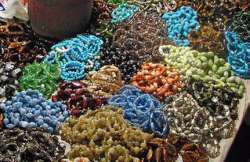Toxic Lead Content Found In Artificial Jewellery
New Delhi: A Toxics Link report on artificial jewellery, specially for children, has reported that all the samples tested by the NGO were found to contain very high levels of lead, which when ingested, could

New Delhi: A Toxics Link report on artificial jewellery, specially for children, has reported that all the samples tested by the NGO were found to contain very high levels of lead, which when ingested, could lead to lead poisoning, reports Times of India.
The NGO clarified that there was no threat if the jewellery was only worn, but there could be serious repercussions if lead was ingested in case the jewellery was taken into the mouth. The study used a sample of 54 pieces of artificial jewellery picked up from various markets like Janpath, Lajpat Nagar and Sadar Bazaar.
These were tested in a lab and found to contain lead between 12.68 parts per million (ppm) and 856,346.9ppm. India only has regulation on content of lead in paints and so far, no laws exist to regulate lead content in jewellery.
Countries such as USA, Canada and the European Union permit lead content of 300ppm, 600ppm and 100ppm respectively in children's products.
‘Artificial jewellery, specially for children, is often coated with paint that contains high levels of lead. Even unpainted jewellery is known to contain lead to make the metal more malleable. Children often have a tendency to put such small pieces in their mouth. Adults also often bite on their bracelets or rings when they are deep in thought.
This is when the lead, which is leachable, gets ingested and poses a serious health risk. Our study shows the extent of the problem in Delhi. We will write to the health ministry to take up the issue,'' said Prashant Rajankar, senior programme officer and researcher. In India, artificial jewellery is mass-produced in states like Assam, Delhi, Kerala, Madhya Pradesh, Maharashtra and Rajasthan.
It is also imported from countries like New Zealand, USA and middle-east countries. Experts say even a small exposure over a long period can have far reaching impacts on health.
‘‘The kind of jewellery that contains lead is metallic, metallic with paint and painted plastic. Jewellery also does not carry any labels. One doesn't know where it is coming from and the market for it is huge. We urgently need guidelines for restricting lead levels in paints, pigments and jewellery. In fact, no lead should be allowed to be added during any process of manufacturing,'' said Rajankar.
The NGO clarified that there was no threat if the jewellery was only worn, but there could be serious repercussions if lead was ingested in case the jewellery was taken into the mouth. The study used a sample of 54 pieces of artificial jewellery picked up from various markets like Janpath, Lajpat Nagar and Sadar Bazaar.
These were tested in a lab and found to contain lead between 12.68 parts per million (ppm) and 856,346.9ppm. India only has regulation on content of lead in paints and so far, no laws exist to regulate lead content in jewellery.
Countries such as USA, Canada and the European Union permit lead content of 300ppm, 600ppm and 100ppm respectively in children's products.
‘Artificial jewellery, specially for children, is often coated with paint that contains high levels of lead. Even unpainted jewellery is known to contain lead to make the metal more malleable. Children often have a tendency to put such small pieces in their mouth. Adults also often bite on their bracelets or rings when they are deep in thought.
This is when the lead, which is leachable, gets ingested and poses a serious health risk. Our study shows the extent of the problem in Delhi. We will write to the health ministry to take up the issue,'' said Prashant Rajankar, senior programme officer and researcher. In India, artificial jewellery is mass-produced in states like Assam, Delhi, Kerala, Madhya Pradesh, Maharashtra and Rajasthan.
It is also imported from countries like New Zealand, USA and middle-east countries. Experts say even a small exposure over a long period can have far reaching impacts on health.
‘‘The kind of jewellery that contains lead is metallic, metallic with paint and painted plastic. Jewellery also does not carry any labels. One doesn't know where it is coming from and the market for it is huge. We urgently need guidelines for restricting lead levels in paints, pigments and jewellery. In fact, no lead should be allowed to be added during any process of manufacturing,'' said Rajankar.